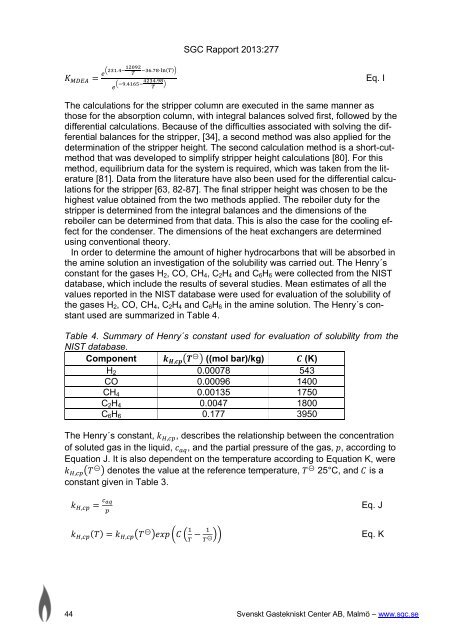Carbon dioxide removal in indirect gasification - SGC
Carbon dioxide removal in indirect gasification - SGC
Carbon dioxide removal in indirect gasification - SGC
Create successful ePaper yourself
Turn your PDF publications into a flip-book with our unique Google optimized e-Paper software.
ܭெ ா = ቀమయభ.రషభమబవమ షయల.ళఴ∙ౢ()ቁ<br />
ቀషవ.రభలఱషరమయర.వఴ<br />
<br />
ቁ<br />
<strong>SGC</strong> Rapport 2013:277<br />
Eq. I<br />
The calculations for the stripper column are executed <strong>in</strong> the same manner as<br />
those for the absorption column, with <strong>in</strong>tegral balances solved first, followed by the<br />
differential calculations. Because of the difficulties associated with solv<strong>in</strong>g the differential<br />
balances for the stripper, [34], a second method was also applied for the<br />
determ<strong>in</strong>ation of the stripper height. The second calculation method is a short-cutmethod<br />
that was developed to simplify stripper height calculations [80]. For this<br />
method, equilibrium data for the system is required, which was taken from the literature<br />
[81]. Data from the literature have also been used for the differential calculations<br />
for the stripper [63, 82-87]. The f<strong>in</strong>al stripper height was chosen to be the<br />
highest value obta<strong>in</strong>ed from the two methods applied. The reboiler duty for the<br />
stripper is determ<strong>in</strong>ed from the <strong>in</strong>tegral balances and the dimensions of the<br />
reboiler can be determ<strong>in</strong>ed from that data. This is also the case for the cool<strong>in</strong>g effect<br />
for the condenser. The dimensions of the heat exchangers are determ<strong>in</strong>ed<br />
us<strong>in</strong>g conventional theory.<br />
In order to determ<strong>in</strong>e the amount of higher hydrocarbons that will be absorbed <strong>in</strong><br />
the am<strong>in</strong>e solution an <strong>in</strong>vestigation of the solubility was carried out. The Henry´s<br />
constant for the gases H2, CO, CH4, C2H4 and C6H6 were collected from the NIST<br />
database, which <strong>in</strong>clude the results of several studies. Mean estimates of all the<br />
values reported <strong>in</strong> the NIST database were used for evaluation of the solubility of<br />
the gases H2, CO, CH4, C2H4 and C6H6 <strong>in</strong> the am<strong>in</strong>e solution. The Henry´s constant<br />
used are summarized <strong>in</strong> Table 4.<br />
Table 4. Summary of Henry´s constant used for evaluation of solubility from the<br />
NIST database.<br />
Component ࡴ ,ࢉ൫ࢀ ⊝ ൯((mol bar)/kg) (K)<br />
H2 0.00078 543<br />
CO 0.00096 1400<br />
CH4 0.00135 1750<br />
C2H4 0.0047 1800<br />
C6H6 0.177 3950<br />
The Henry´s constant, ݇ ு ,, describes the relationship between the concentration<br />
of soluted gas <strong>in</strong> the liquid, ܿ , and the partial pressure of the gas, , accord<strong>in</strong>g to<br />
Equation J. It is also dependent on the temperature accord<strong>in</strong>g to Equation K, were<br />
݇ ு ,൫ܶ ⊝ ൯denotes the value at the reference temperature, ܶ ⊝ 25°C, and ܥ is a<br />
constant given <strong>in</strong> Table 3.<br />
݇ ு , = ೌ<br />
<br />
݇ ு , (ܶ) = ݇ ு ,൫ܶ ⊝ ൯݁ݔ൬ܥ ቀ ଵ<br />
்<br />
− ଵ<br />
் ⊝ቁ൰<br />
Eq. J<br />
Eq. K<br />
44 Svenskt Gastekniskt Center AB, Malmö – www.sgc.se

















